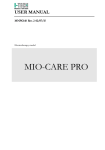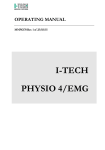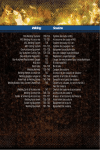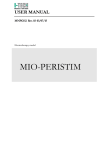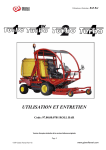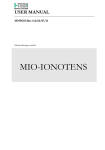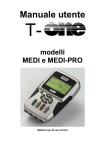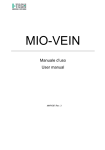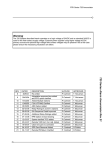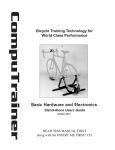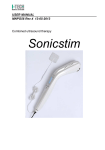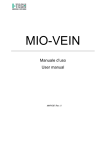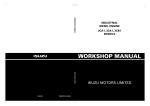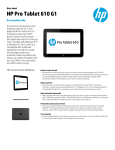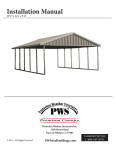Download MNPG06-03 (Man T-ONE Medi-Pro ENG) - I
Transcript
USER MANUAL Tmodel MEDI & MEDI-PRO MNPG06 Rev.03 – 02/12/2011 WARNING: T-ONE IS A MEDICAL DEVICE. Consult your doctor before using T-ONE if you suffer from health problems. Read the contraindications and warnings carefully before using the medical programs. Manufactured in compliance with the 93/42/EEC directive concerning medical devices by IACER S.r.l. via Pertini 24/A, 30030 Martellago (VE) [email protected] www.itechmedicaldivision.com Pag. 2 USER MANUAL T-ONE Medi/Medi-Pro cod. doc. MNPG06-03 USER MANUAL – TABLE OF CONTENTS 1. T-ONE kit contents; Page 4 2. Purpose Contraindications and side effects Page 4 3. Warnings Page 5 4. Legend of symbols marked on T-ONE and found in the manual Page 6 5. How to use T-ONE Description of controls – Preliminary instructions – Operating instructions Page 6 6. Battery charging Page 8 7. T-ONE maintenance and storage Page 10 8. Resolution of problems and questions Page 10 9. Electrostimulation and T-ONE stimulation intensities Page 11 10. T.E.N.S. programs Page 12 11. REHAB programs Page 18 12. FITNESS programs Page 21 13. Custom programs (only model MEDI-PRO) Page 27 14. SET UP Page 29 15. Self-adhesive electrodes Page 30 16. Technical specifications Page 30 17. Assistance Page 31 USER MANUAL T-ONE Medi/Medi-Pro MNPG06-03 Pag. 3 1. T-ONE kit contents 1 T-ONE electronic stimulator; 4 connection cables, for the transmission of electric impulses; 2 packages containing 4 pre-gelled self-adhesive 48x48 mm electrodes; 2 packages containing 4 pre-gelled self-adhesive 50x90 mm electrodes; 1 packages containing 8 round pre-gelled self-adhesive 32 mm diameter; 1 battery charger; 4 rechargeable Ni-Mh batteries AA (8 for model MEDI-PRO) 1 T-ONE user manual; 1 electrode position manual; 1 Ionophoresis Kit; 1 carry bag; Spare parts available: • • • • Pre-gelled self-adhesive electrodes 48x48mm, 50x90mm, round 32mm Ionophoresis pads: 60x80mm • 80x120mm; Elastic band for Ionophoresis treatment 80 mm high (code FI80X60) Set elastic band for legs drainage (codes FC250-265 and FP235-245); 2. Purpose. The T-ONE electronic stimulator is a medical device specifically intended for adults with adequate knowledge of the device acquired from reading the manual for domestic use. T-ONE is used to apply electrical microimpulses, capable of producing energy, to the human body. This energy, modulated in accordance with parameters typical to each impulse, can be used for various purposes, from pain reduction to winding-down exercises, from muscle strengthening to drainage, from isotonic exercises to treating haematomas, to the treatment of imperfections using the beauty programs. We recommend to consult your doctor before using TENS and REHAB programs. Contraindications. This device must not be used by people with a pace-maker, epileptics, pregnant women, people with a high temperature, anxious people or people suffering from heart disease, phlebitis, thrombophlebitis or serious illnesses. In the event of injury, muscle stress or any other health problem use the device only under medical supervision. The ionophoresis program uses monophasic impulse, so it is polarizing: do not use near metallic prosthesis under skin (minimum 10 cm from metallic prosthesis). Side effects No significant side effects are known of. Some particularly sensitive people have reported skin redness in the area where the electrodes were positioned: the redness usually disappears a few minutes after the end of the treatment. Should the redness persist please consult a doctor. In rare cases, stimulation carried out in the evening can cause some people to experience difficulty in falling asleep. If this occurs, suspend the treatment and consult a doctor. Pag. 4 USER MANUAL T-ONE Medi/Medi-Pro cod. doc. MNPG06-03 3. Warnings. T-ONE has been designed and manufactured to be operated with 4 rechargeable AA batteries. • The device must not be used in the presence of patient monitoring equipment. • Do not use T-ONE with electrosurgical or shortwave or microwave therapy equipment . • Use of the device is prohibited to persons known to be of unsound mind. • Use of the device is prohibited to persons suffering from sensibility disorders. • Use of the device is prohibited to permanently or temporarily disabled persons unless assisted by qualified personnel (e.g. a doctor or therapist). • Use of the device is prohibited in the presence of signs of deterioration of the device itself. Should any foreign matters penetrate the device contact the retailer or manufacturer immediately. If dropped, check that the housing is not cracked or damaged in any way; if so, contact the retailer or manufacturer. Should you notice any changes in the device’s performance during treatment, interrupt the treatment immediately and consult the retailer or manufacturer (patients being treated in a centre must also be informed of the event). • Use of the device is prohibited in combination with other medical devices. • Use of the device is prohibited close to flammable substances or in environments with high concentrations of oxygen. • Consult a doctor before using T-ONE with metallic osteosynthesis devices. Muscle heaviness and cramps may be experienced in the event of prolonged muscle stimulation. Should this occur we recommend suspending treatment with T-ONE for a few days and then continuing with muscle recovery and capillarization programs. Make sure that the plug and battery charger are intact. Should one of these parts show any sign of damage, suspend use of the battery charger immediately and contact the retailer or manufacturer. Only use battery chargers supplied by the manufacturer; the use of battery chargers not supplied by the manufacturer will free the same from any responsibility related to damage to the equipment or user, and will expose the user to risks such as short circuits and fire. • It is forbidden to position the electrodes in such a way that the current crosses the heart area (e.g. a black electrode on the chest and a red electrode on the shoulder blade); however electrodes can be positioned along the muscular fascia of the heart area, as used for pectoral strengthening. • Use of the device is prohibited with electrodes positioned on or close to injuries or cuts. • The electrodes must not be positioned on the carotid sinuses (carotid) or genitals. • The electrodes must not be positioned close to the eyes; make sure that the current delivered does not cross the eyeball (one electrode diametrically opposite to the other in relation to the eye); keep a distance of at least 3 cm. from the eyeball. • When using the electrodes, follow the instructions given in this manual and on the package of the electrodes themselves. Use single-patient electrodes, supplied exclusively by the manufacturer or retailer, and take great care to avoid the exchange of electrodes between different users. T-ONE has been tested and guaranteed for use with the electrodes supplied. • Insufficiently sized electrode sections can cause skin reactions or burns. Only use the round electrodes supplied by the manufacturer for facial applications. • Do not use electrodes when damaged, even if they stick to the skin well. • Electrodes must not be used when they no longer stick to the skin. Repeated use of the same electrodes can compromise the safety of the stimulation, in fact it can cause skin redness that can last for many hours after stimulation. • Warning! During treatment with round and 35 x 45 mm. electrodes, current density may be in excess of 2 mA/cm² for each electrode. In these cases take special care regarding any skin redness. • Do not use anal or vaginal probes in event of skin or muscle injuries. Do not use without a medical prescription. USER MANUAL T-ONE Medi/Medi-Pro MNPG06-03 Pag. 5 4. Legend of symbols marked on T-ONE and found in the manual. Manufactured in compliance with the 93/42/EEC directive concerning medical devices Internally powered device with type BF applied parts Product subject to WEEE regulations concerning separate waste collection Read the instructions for use carefully before using the device ON/OFF button. Select program and muscles to stimulate. Multifunction buttons: select Sport, Beauty or Tens program, male, female and skip phase. Start/Stop program, confirm selection and pause. Increase intensity. Decrease intensity. 5. How to use T-ONE. Pag. 6 USER MANUAL T-ONE Medi/Medi-Pro cod. doc. MNPG06-03 Preliminary instructions. Before using T-ONE clean the skin of the area to be treated; with the cable disconnected from T-ONE, connect the electrostimulation cable jacks to the self-adhesive electrodes; position the self-adhesive electrodes on the skin (see photos of electrode positions); connect the impulse transmission cables to the relative jacks (Channel 1 and/or Channel 2), then turn T-ONE on. Warning: make sure that T-ONE is switched off before disconnecting the electrodes at the end of the treatment. Operating instructions (N.B. read the whole manual before using the equipment) 1. Turn T-ONE on using the button 2. Select the program group: Sport, Beauty, Tens, Mem (only Medi-Pro version) using the button 3. Select the program using the 4. buttons Select male or female with buttons . Female selection Male selection 5. Select the muscle group with Arms male trunk male buttons Legs male Arms female trunk female Legs female 6. press to start program; the display shows connect cables and electrodes and increase intensity of the used channels; to start intensity press for each used channel; T-ONE will begin the session. 7. press the button for each use channel to increase current intensity until the personal tolerance level is reached. USER MANUAL T-ONE Medi/Medi-Pro MNPG06-03 Pag. 7 A bar indicating the start and end of a contraction will appear on the display whilst the electronic stimulator is working. The periods of muscular contraction (bold bar) and the periods of recovery (dotted or striped bar) are graphically visualised under the bar with a cursor. This enables the user to know exactly when a contractions starts. 8. At the end of the first phase, the T-ONE cancels the previously selected intensity, and warns button for the the user with an intermittent signal; to continue with the program, press the relevant channels again until you reach the desired level of stimulation. An audio signal will sound three times when the program has finished. 9. At the end of the program switch off the T-ONE and remove the cables. Attach the electrodes to the transparent films and replace them in their original packaging. Option to simultaneously increase the intensity on all channels: Select the desired program: Start program Increase each channel to at least intensity 1: CH1 CH2 CH3 CH4 Red White Blue Yellow To simultaneously increase the intensity of all channels use the following buttons: Increase Skip phase: press the Decrease button during the working program to skip to the next phase. Pause/stop program: during the working program, press the momentarily pause the normal working cycling. Press the button once to button again to restart the program. Switch off the machine to stop the program. 6. Battery charging. The display shows when the battery is low of energy: Batteries fully charged Batteries partially discharged Batteries fully discharged BATTERY CHARGER SPECIFICATIONS: see battery charger datasheet. Use only battery charger supplied by the manufacturer or by authorized dealers. Using other battery chargers can seriously compromise equipment and user safety. Batteries specifications: use only AA type batteries like the ones supplied with the equipment (rechargeable Ni-Mh AA 1,2V or Alkaline AA 1,5V ). The manufacturer is not responsible for damages due to the use of different batteries. WARNING: do not recharge other batteries than the ones supplied with Ni-Mh battery charger. Pag. 8 USER MANUAL T-ONE Medi/Medi-Pro cod. doc. MNPG06-03 Recharging instructions: • Insert the rechargeable batteries into the charger respecting the indicated polarity; • Connect the charger to the domestic plug. • The batteries need 8/12 hours for a complete charge. • During charging, both batteries and charger get warm: this is a normal condition and do not imply any danger. WARNING: disconnect the battery charger from domestic plug when not in use. Do dot immerge the battery in water or other liquids and do not expose it to heat sources. Do not dispose of discharged or defective batteries with domestic waste; dispose of in an authorised waste collection bin. Before storing T-ONE for long periods of time, we recommend that it is fully charged and stored in a dry place, checking that it is switched off. Do not use the battery charger if: • The plug is damaged or parts of it are broken. • It has been exposed to rain or any other type of liquid. • The components have been damaged by a fall. Do not immerge the battery charger in water. Use a dry cloth to clean the battery charger. Do not open the battery charger: it does not contain repairable parts. USER MANUAL T-ONE Medi/Medi-Pro MNPG06-03 Pag. 9 7. T-ONE maintenance and storage. We recommend that T-ONE is switched off and the cables are removed from the connectors at the end of every session. T-ONE should be kept in the carry bag supplied, together with the rest of the equipment supplied with it, and carefully stored on a secure surface and protected from situations listed in the Warnings paragraph. T-ONE should be stored in the following conditions: Temperature: Maximum relative humidity: Atmospheric pressure: from -20°C to +40°C 75% from 700 hPa to 1060 hPa Cleaning: only clean the device using a dry cloth. We recommend that the device be subjected to a functional test carried out by the manufacturer every 24 months. The manufacturer retains that the T-ONE device cannot be repaired by personnel external to its own company. Any work of this nature carried out by personnel not authorised by the manufacturer will be classed as tampering with the device, freeing the manufacturer from responsibility for the warranty and hazards that the operator or user may be exposed to. N.B. disconnect the cables before placing the electronic stimulator in the bag. If not, the cables will bend excessively close to the connectors. This may damage the cables. 8. Resolution of problems and questions. Any type of work on T-ONE must be carried out exclusively by the manufacturer or by an authorised dealer. In any event, any presumed malfunction of T-ONE must be verified before sending the device to the manufacturer. Here below are some typical situations: T-ONE cannot be turned on: • Ensure of presence of batteries in the unit. • Recharge the batteries and try to switch it on again. • Check that the ON/OFF button has been pressed correctly (held down for at least one second). • Check that batteries have correct polarity of the batteries. T-ONE does not transmit electric impulses: • Check that the cable jacks have been inserted in the electrodes and that the plastic protection has been removed from the electrode. • Check that the cables have been connected correctly (connector well inserted in the device). T-ONE switches off during operation: • Recharge the batteries and start the treatment again. If the problem persists contact the manufacturer. Disposal To protect the environment, the device, its accessories and above all the batteries must be disposed of in areas equipped for that purpose or as special waste. Product subject to WEEE regulations concerning separate waste collection Pag. 10 USER MANUAL T-ONE Medi/Medi-Pro cod. doc. MNPG06-03 9. Electrostimulation and stimulation intensity. Electrostimulation consists of the transmission of electric microimpulses to the human body. Fields of application of electrostimulation are: pain therapy, recovery of muscle trophism after injury or a surgical operation, athletic preparation and beauty treatments. Specific electric impulses are used for every one of these applications. The stimulation intensity is displayed on the T-ONE screen for each channel in a scale progressing from 0 to 120. The types of impulses can be classified as follows: 1. Tens impulse: for tens programs, the intensity should be adjusted to a level between the thresholds of perception and pain. The maximum limit is reached when the muscles surrounding the area treated begin to contract. It is best to stay below that limit. 2. Ionophoresis impulse: the intensity must be strong enough to produce a relevant perception, near pain, till the muscles surrounding the area treated begin to contract. 3. Lipolysis/drainage impulse: the “pump” effect is produced by sequential tonic contractions. The intensity must be enough to produce these contractions: the greater the contraction is, the greater the pump effect will be. But beware: there is no benefit to be gained from enduring intensity high enough to cause pain. The first electrostimulation sessions should be carried out at a low intensity to allow the organism to get used to new sensations. That way intensity can be increased gradually and will not be traumatic. 4. Warming-up impulse: in this case stimulation intensity must be increased gradually to increase the metabolism of the muscle concerned gradually. A bit like with a car: the engine needs warming-up before it is taken to full speed. 5. Toning, training, atrophy contraction impulse: the muscle treated must visibly contract during a training impulse. The fact that the muscle tends to stiffen and increase in volume will be visible to the naked eye. Intensity should be increased gradually (in the first contraction) to enable you to identify the right level of stimulation comfort. Intensity can be increased up to the personal tolerance threshold during the second training contraction; this operation is then repeated during each contraction until the workload reaches the level of intensity recommended in the description of the single programs. We recommend that you record the level of intensity reached in order to try to improve the level of stimulation and consequently your performance. 6. Massage, winding down, active recovery impulse: intensity must be adjusted gradually to massage the muscle treated. The level of intensity should be sufficient to obtain a comfortable massage. Bear in mind that there is no need to endure high intensity levels in this case as it is meant to be a massage, meaning that intensity can be increased gradually without excesses. 7. Capillarization impulse: increase the intensity gradually to produce constant, visible stimulation of the area treated; a medium stimulation threshold is recommended, always below the pain threshold. USER MANUAL T-ONE Medi/Medi-Pro MNPG06-03 Pag. 11 10. T.E.N.S. Programs. The product conforms to the 93/42/EEC directive concerning medical devices for the following programs. WARNING! It must be remembered that an electronic stimulator is a very effective analgesic instrument and that pain can indicate various types of medical conditions! The Tens1 to Tens20 programs described in this paragraph are analgesic. You are advised to read the manual carefully before using T-ONE. REMEMBER THAT PAIN IS A SIGN: consult a doctor to identify the medical condition before using T-ONE! TENS, an acronym standing for “transcutaneous electrical nerve stimulation”, is a therapeutic technique mainly used for analgesic purposes to counter the effects (usually pain) of a wide variety of medical conditions. For this purpose it finds application in treating everyday ailments troubling mankind: neck pain, arthrosis, myalgia, neuritis, back pain, periarthritis, heaviness in legs, muscle weakness, just to mention a few. On an academic level, TENS can be divided into various categories according to the mechanism used to reduce the pain. The main types are: conventional TENS (or fast analgesic), electro acupuncture training TENS (or delayed analgesic), TENS at maximum values with antidromic action and consequently an immediate local anaesthetic effect. The rehabilitative action of TENS is represented by its power to reduce pain thereby restoring physiological conditions; more often than not this allows the patient to regain normal motor function. Consider a patient suffering from irritating periarthritis; they either resort to using analgesics or learn to live with the pain that often makes even the simplest movements impossible. Immobility reduces metabolic activity making it impossible to eliminate algogenic substances. So a vicious circle begins. In addition to relieving pain, TENS causes induced muscle stimulation increasing metabolic activity and blood flow and improving tissue oxygenation with an intake of nutritional substances. So the positive effect can be amplified by combining TENS with muscle stimulation of the area concerned. Position of electrodes and intensity levels. The electrodes should be positioned to form a square surrounding the painful area using Channel 1 and Channel 2 as shown in illustration 1. The intensity should be adjusted to a level between the thresholds of perception and pain: the maximum intensity level is the moment in which the muscles surrounding the area treated begin to contract; over this limit stimulation does not become more effective, just more irritating, so it is best to stop before that point. illustration 1 WARNING Create a square area with the electrodes, over the painful zone. Keep 4cm minimum distance between electrodes. Pag. 12 USER MANUAL T-ONE Medi/Medi-Pro cod. doc. MNPG06-03 T01 • rapid TENS. (Medical program). Program also called conventional tens, used for analgesic purposes; its purpose is to induce the organism into blocking pain at the spine, in accordance with the “Gate Control Theory” by Melzack and Wall. Pain impulses leave part of the body (for example the hand) and run along the nerve tracts (through small-diameter nerve fibres) until they reach the central nervous system where the impulses are interpreted as pain. Conventional tens activates large-diameter nerve fibres, blocking the path of small-diameter nerve fibres at the spine. So action is mainly taken against the symptom: to simplify it further, the wire transmitting pain information is obstructed. Treatment duration should be no less than 30/40 minutes. Conventional tens is a current that can be used to treat general everyday pain. The average number required to benefit from the treatment is 10/12 per day (there are no contraindications for up to double this amount). The program has a duration of 40 minutes in a single phase. The program can be repeated at the end of the session for particularly persistent pain. The nature of the impulse means that the patient may experience an “addictive” effect due to which the impulse will be felt less and less: if necessary the intensity can be increased by one level to counter this effect. Position of electrodes: form a square above the painful area as shown in illustration 1. T02 • endorphinic TENS. (Medical program). This type of stimulation produces two types of effects according to how the electrodes are positioned: positioning the electrodes in the dorsal region, see photo 08 in the positions manual, promotes the endogenous production of morphine-like substances capable of raising the pain perception threshold; positioning the electrodes to form a square above the painful area as shown in illustration 1 produces a vascularizing effect. Vascularization increases arterial flow and consequently aids the removal of algogenic substances and helps to restore normal physiological conditions. Treatment duration 30 minutes in a single phase, daily frequency. Do not position the electrodes close to inflamed areas. Intensity adjusted for good solicitation of the part stimulated, the sensation must be similar to that of a massage. USER MANUAL T-ONE Medi/Medi-Pro MNPG06-03 Pag. 13 T03 • TENS sequential. (Medical program). The action of this program is very similar to the one of T01 program. During stimulation, this program modifies by itself the frequency and impulse width so to contrast the habit at the stimulation (no need to continuously adjust the intensity value). Select the intensity at the beginning of the program and maintain it till the end of the program. In the event during the program current perception decreases a lot, do not increase intensity value and wait till the end of therapy. TENS program is working properly. Program duration: 20 minutes for each phase. Intensity: set above the threshold of perception. Position of electrodes: form a square on the painful area as shown in illustration 1 or see pictures from 25 to 33. T04• TENS at maximum values. (Medical program). Very short duration, 3 minutes. Blocks pain impulses peripherally creating a proper anaesthetising effect in the area treated. This type of stimulation is suitable for injuries or bruises when rapid action is required. The intensity selected is the maximum tolerable value (well in excess of conventional tens, and therefore with considerable contraction of the muscles surrounding the area treated). That is the reason why such stimulation is undoubtedly the least tolerated but is extremely effective. This type of stimulation is not recommended for particularly sensitive people and in any case the electrodes should not be positioned in sensitive areas such as the face and genitals or close to wounds. Position of electrodes: form a square above the painful area as shown in illustration 1. T05 • TENS Burst impulse. (Medical program). This program produces a training effect using the frequencies of conventional TENS. Useful for pain therapy. The action is similar to the one of endorphinic TENS, with a treatment time of 15 minutes for a phase. Position of electrodes: form a square above the painful area as shown in illustration 1. T06 • Microcurrent. (Medical program). The use of microcurrent is very similar to conventional Tens, the only difference is the use of the very fine electric impulse, more suitable for the sensibility of slightly anxious people, or for more delicate parts of the body. It can generally be applied for everyday pains, bearing in mind that you should always consult your doctor to identify the cause of the pain. It is considered a good all-purpose analgesic current, as it does not have any side effects (except slight skin redness after long applications), and has very few contraindications (those specified in the paragraph at the beginning). Program duration: 30 minutes. Intensity set above the threshold of perception. Position of electrodes: above the painful area as shown in illustration 1. T07 • Vascularization. (Medical program). Has a vascularizing effect on the area treated. Vascularization increases arterial flow and consequently aids the removal of algogenic substances and helps to restore normal physiological conditions. Do not position the electrodes close to inflamed areas. Daily application is recommended, the number of applications is not defined; the program can be used to reduce pain. Stimulation intensity should be between the thresholds of perception and slight discomfort. Program duration: 20 minutes. Position of electrodes: see photo 25 and 33 in the manual of positions. Pag. 14 USER MANUAL T-ONE Medi/Medi-Pro cod. doc. MNPG06-03 T08 • Decontracting. (Medical program). Program used to speed up the recovery of muscle function after intense training or strain from work; the effect is immediate. Adjust the intensity for moderate muscle solicitation. Two treatments per day for three or four days. Program duration: 35 minutes. Position of electrodes: from photo 1 to 28. T08 Decontracting Program duration: 35 minutes Electrodes positioning: Create a square area with the electrodes, over the painful zone. Phase 1 Short width Tens impulse 15 min. Phase 2 Large width Tens impulse 20 min. T09 • Anti-inflammatory. (Medical program). Program recommended for inflammatory conditions. To be applied until the inflammatory state is lessened (10-15 applications, once a day; the daily treatments can be doubled if required). Identify the area to be treated and position the electrodes as shown in illustration 1. Adjust the intensity until a tingling feeling is produced in the area treated; avoid contracting the surrounding muscles. Program duration: 30 minutes. T10 • Neck pain / Headache. (Medical program). Specific program for the treatment of pain in the neck area. The intensity should be adjusted to a level between the thresholds of perception and pain: the maximum intensity level is the moment in which the muscles surrounding the area treated begin to contract; over this limit stimulation does not become more effective, just more irritating, so it is best to stop before that point. The first benefits can be seen after 10 to 12 treatments carried out on a daily basis; proceed with the treatment until the symptoms pass. Position of electrodes: photo 25. T10 Neck pain/Headache Eletcrodes Positioning: cervical zone (photo 25). Program duration: 30 minutes Phase 1 Short width Tens impulse 30 min. Phase 2 Decontracting 3 min. T11 • Backache/Sciatic pain. (Medical program). Specific program for the treatment of pain in the lumbar area or along the sciatic nerve, or both. The intensity should be adjusted to a level between the thresholds of perception and pain: the maximum intensity level is the moment in which the muscles surrounding the area treated begin to contract; over this limit stimulation does not become more effective, just more irritating, so it is best to stop before that point. The first benefits can be seen after 15 to 20 treatments carried out on a daily basis; proceed with the treatment until the symptoms pass. Program duration: 35 minutes. Position of electrodes: see photo 27 and 28 in the manual of positions. T11 Lumbal/sciatic pain Electrodes positioning: lumbal area (photo 27), sciatic area (photo 28). Phase 1 Short width Tens impulse 30 min. Program duration: 35 minutes Phase 2 Tens Burst impulse 5 min. USER MANUAL T-ONE Medi/Medi-Pro MNPG06-03 Pag. 15 T12 • Sprains / Bruises. (Medical program). The program develops its effectiveness after this type of injury by inhibiting pain locally, producing three selectively acting, differentiated impulses. The intensity should be adjusted to a level between the thresholds of perception and pain. Number of treatments: until pain is lessened, on a daily basis (even 2/3 times a day). T12 Sprains /Bruises Electrodes positioning: ankle (photo 32). Phase 1 Program duration: 30 minutes Phase 2 Tens rapid 15 min. Emathoma impulse 15 min. T13 • Hand and wrist pain. (Medical program). This program is suitable for all types of hand and wrist pain: aching caused by strains, arthritis in the hand, carpal tunnel syndrome, etc. Total program duration: 40 minutes. A combination of various types of square-wave impulses has a general analgesic effect on the area to be treated (impulses at different frequencies stimulate different sized nerve fibres promoting an inhibitory action at spinal level). The intensity should be adjusted to a level between the thresholds of perception and pain, without causing muscle contraction: Position of electrodes: form a square above the area to be treated as shown in illustration 1. T13 Hand and wrist pain Electrodes positioning: wrist (photo 33). Phase 1 Tens 70Hz, 15 min Program duration: 40 minutes Phase 2 Tens 90Hz, 15 min Phase 3 Tens 110Hz, 10 min T14 • Plantar stimulation. This program has a relaxing and draining effect on the limb stimulated. It is ideal for people suffering from a sense of “heaviness in the legs”. Duration: 40 minutes. Intensity: just above the threshold of perception. Position of electrodes: 2 electrodes (one positive, the other negative) on the sole of the foot, one close to the toes, the other under the heel. T14 Plantar stimulation Phase 1 Tens 70Hz, 15 min Phase 2 Tens 2Hz, 15 min Program duration: 40 minutes Phase 3 Tens 90Hz, 10 min T15 • Epicondylitis. (Medical program). Also known as “tennis elbow”, it is an insertional tendinopathy concerning insertion of the elbow bone into the epicondylar muscles, those enabling finger and wrist extension (bending backwards). 15 applications once a day (even twice), until the symptoms pass. We recommend that you consult your doctor to identify the precise cause of the pain in order to prevent the condition from reoccurring. Program duration 40 minutes, intensity adjusted above the threshold of perception. Position of electrodes: photo 29. T15 Epicondylitis Electrodes positioning: photo 29. Phase 1 Tens 90Hz, 20 min Program duration: 40 minutes Phase 2 Tens 70Hz, 10 min Pag. 16 USER MANUAL T-ONE Medi/Medi-Pro cod. doc. MNPG06-03 Phase 3 Tens 50Hz, 10 min T16 • Epitroclea. (Medical program). Also known as “golfing elbow”, it affects golfers but also those who carry out repetitive tasks or tasks involving frequent intense strain (for example carrying a particularly heavy suitcase). It causes pain in the flexor and pronator tendons inserted in the epitroclea. Pain is felt when bending or straightening the wrist against resistance, or when clenching a hard rubber ball in the hand. 15 applications once a day (even twice), until the symptoms pass. We recommend that you consult your doctor to identify the precise cause of the pain in order to prevent the condition from reoccurring. Program duration 40 minutes, intensity set above the threshold of perception. Position of electrodes: photo 29 but with all of the electrodes positioned on the inside of the arm (with a rotation of about 90°). T16 Epitroclea Electrodes positioning: photo 29 with electrodes rotated 90° Phase 1 Tens 90Hz, 20 min Program duration: 40 minutes Phase 2 Tens 70Hz, 20 min T17 • Periarthritis. (Medical program). Scapulo-humeral periarthritis is an inflammatory condition affecting the fibrous tissues surrounding joints: tendons, serous sacs and connective tissue. These appear altered and can break into fragments and calcify. If neglected, this condition can become heavily crippling. For this reason, after carrying out a cycle of 15/20 applications once a day, we recommend that you consult your doctor for a cycle of specific rehabilitation exercises to reduce the pain. The Tens17 program consists of various phases including Tens and muscle stimulation aimed at improving the tone of the muscles surrounding the joint. Program duration 41 minutes, intensity set above the threshold of perception with small muscle contractions at the end of the program (10 minutes before the end). T17 Periarthritis Electrodes positioning: periarthritis (foto 26). Phase 1 Phase 2 Tens 150Hz, 1 min Tens 90Hz, 30 min Program duration: 41 minutes Phase 3 Muscle stimulation, 10 min T18 • Heaviness in legs. This program is used to improve blood flow and muscle oxygenation speeding up the elimination of lactic acid (produced after anaerobic sessions for muscle definition), reducing soreness and the risk of contractures. Thanks to this program the muscle treated will be ready for a new training session or competition much more quickly. Program duration: 25 minutes. Recommended initial intensity: medium-low, enough to produce good movement of the part treated; increase intensity progressively until the muscle treated is subjected to a strong massage. Position of electrodes: see photos 01 to 20 in the manual of positions. T18 Heaviness in legs Electrodes positioning: photo 21A and 21B. Phase 1 Phase 2 EMS, 10 min Tens 3Hz, 5 min Program duration: 25 minutes Phase 3 Tens 1Hz, 10 min USER MANUAL T-ONE Medi/Medi-Pro MNPG06-03 Pag. 17 11. REHAB Programs. R01/R02 • Ionophoresis 1 / Ionophoresis 2. (Medical program). Ionophoresis is an electrotherapic technique that uses continuous current to carry drugs into painful area or contracture area. Ionophoresis means “ions transport”: through continuous current, active pharmacologic ions are driven through the skin. Electric current favours drugs penetration into the cells, and at the same time it stimulates the elimination of metabolic slag. The drug can have negative polarity, positive polarity or double polarity. The current induce the drug to run from one pole to the other, crossing the painful area and releasing the specific active ingredient. WARNING: before starting the therapy, wet the sponge electrodes and wring them so to avoid dripping, then put the drug on the electrode as follow: • Active polarity drug: dissolve this drug on the electrode connected to positive pole (red connector) • Negative polarity drug: dissolve this drug on the electrode connected to negative pole (black connector) • Double polarity drug: can be dissolved on positive pole or negative pole without distinction. Position the electrode with the drug on painful area, and the other electrode horizontally. Program duration: 20 minutes. Select channel 1 or channel 2 (select both channel only if you need to stimulate two different areas). Position the electrodes (positive and negative) horizontally to the treatment area. Channel 3 and channel 4 are disconnected. Set up an intensity value so to have “pins and needles” on treatment area. At the end of the program, the skin could lightly turn bright red; the reddening usually vanishing few minutes after the end of program. Program 1 works at 1000 Hz, program 2 works at 1500 Hz. Program 2 has a stronger action in carry drugs trough skin than program 1, but also has a higher probability of skin reddening. Do not use ionophoresis program near metallic prosthesis. R03 • Atrophy prevention. (Medical program). Program created to maintain muscle trophism. This treatment concentrates on muscle toning, paying particular attention to slow-twitch fibres. Particularly indicated for patients recovering from an accident or an operation. Prevents the reduction of muscle trophism caused by physical inactivity. The muscle area concerned can be stimulated with daily applications of medium intensity; if you increase the intensity, leave a day of rest between applications to allow the muscles to recover. The intensity of this program Pag. 18 USER MANUAL T-ONE Medi/Medi-Pro cod. doc. MNPG06-03 must be adjusted to produce good muscle contraction in the area treated. Position of electrodes from photo 1 to photo 20. Program duration: 30 minutes. R03 Atrophy prevention Program duration: 30 minutes Biceps (photo 02/15),Triceps (photo 03/16), Extensors (photo 04),Flexors (photo 05), Deltoid (photo 06). Abdominals (photo 01/20), Pectoral/Breast (photo 07/17), Trapezius (photo 08), Large dorsal (photo 09), Gluteus (photo 19), Obliques (photo 22). Quadriceps (photo 11/18), Biceps femoris (photo12), Calves (photo13), Anteriore tibial (photo14). Phase 1 5 min. warm up Phase 2 10 min. 9 sec. recovery 6 sec. work Phase 3 10 min. 9 sec. recovery 6 sec. work Phase 4 5 min. recovery R04 • Atrophy-trophism rehabilitation. (Medical program). This program acts selectively on slow-twitch fibres. Ideal for recovering muscle trophism after a long period of inactivity or an accident. Program to be carried out when loss of muscle tone has already occurred. Apply with caution (at low intensity, enough to produce light muscle contractions) in the first 2/3 weeks. Increase intensity progressively over the next 3/4 weeks. Application on alternate days. Position of electrodes from photo 1 to photo 20. Program duration: 30 minutes. R04 Atrophy Program duration: 25 minutes Biceps (photo 02/15),Triceps (photo 03/16), Extensors (photo 04),Flexors (photo 05), Deltoid (photo 06). Abdominals (photo 01/20), Pectoral/Breast (photo 07/17), Trapezius (photo 08), Large dorsal (photo 09), Gluteus (photo 19), Obliques (photo 22), hip (photo 23) Quadriceps (photo 11/18), Biceps femoris (photo12), Calves (photo13), Anteriore tibial (photo14). Phase 1 3 min. warm up Phase 2 25 min. 6 sec. recovery + 6 sec. work Phase 3 2 min. recovery R05 • Sequential tonic contractions 1. This program increases microcirculation within and around the muscle fibres treated creating rhythmic contractions, fostering better drainage and toning. It can also be applied to older people to improve blood and lymphatic circulation in the lower limbs (e.g. applying CH1 to the right calf, CH2 to the left calf, CH3 to the right thigh, CH4 to the left thigh). These programs can be carried out using self-adhesive electrodes. Stimulation intensity must be sufficient to produce good muscle contractions during the treatment but not enough to cause any soreness. It mainly works on slow-twitch fibres. USER MANUAL T-ONE Medi/Medi-Pro MNPG06-03 Pag. 19 R05 sequential tonic contractions 1 Muscles: all you want to stimulate in a sequence Phase 1 Phase 2 3 min. warm up 10 min. sequential contractions on 4 channels 6 sec duration each. Program duration: 25 minutes Phase 3 Phase 4 10 min. sequential contractions on 4 channels 6 sec duration each. 2 min. recovery R06 • Sequential phasic contractions 2. This program produces rhythmic contractions with a stimulation frequency typical of fast-twitch fibres. Thanks to the high stimulation frequency it is suitable for increasing muscle strength sequentially. The programs produce sequential phasic contractions on four channels. Stimulation intensity must be sufficient to produce good muscle contractions during the treatment but not enough to cause any soreness. Unlike the previous program, this one uses a higher stimulation frequency during the contraction phase and therefore works mainly on fast-twitch fibres. R06 Sequential prasi contractions 2 Muscles: all you want to stimulate in a sequence Phase 1 Phase 2 3 min. warm up 10 min. sequential contractions on 4 channels 6 sec duration each. Program duration: 25 minutes Phase 3 Phase 4 10 min. sequential contractions on 4 channels 6 sec duration each. 2 min. recovery R07 • Stress incontinence. (Medical program). Program duration 9 minutes (two phase 4+5 minutes), intensity set above the threshold of perception to produce light internal stimulation. This program, for which no photographs are provided regarding the position of the electrodes, requires the use of appropriate internal stimulation probes, supplied separately together with the relative instructions. We recommend to consult your doctor before using this program. R08 • Urgency incontinence. (Medical program). Program duration 9 minutes (two phases 4+5 minutes), intensity set above the threshold of perception to produce light internal stimulation. This program, for which no photographs are provided regarding the position of the electrodes, requires the use of appropriate internal stimulation probes, supplied separately together with the relative instructions. We recommend to consult your doctor before using this program. WARNING: on program R07 and R08, we suggest to use certified probes (class IIa medical devices). Datasheet of the probes must contains how to use informations, storage and cleaning precautions and any other useful informations R09 • Haematomas. (Medical program). Consult a doctor before using this program to treat haematomas. Total program duration: 20 minutes. Few applications carried out within a few hours of the bruise. A combination of various types of square-wave impulses has a graduated draining effect on the area to be treated (impulses at different frequencies drain the area at different depths). The intensity should be adjusted to a level between the thresholds of perception and pain, without causing Pag. 20 USER MANUAL T-ONE Medi/Medi-Pro cod. doc. MNPG06-03 muscle contraction. Position of electrodes: form a square above the area to be treated as shown in illustration 1. 12. Fitness program. IMPORTANT. Intensity of stimulation: fitness programs (Firming up, Toning up, Strength, Resistance/Endurance, Agonist/Antagonist) are divided in 3 phases: warm up phase, work phase, recovery phase. During warm up phase (phase1) the intensity of stimulation has to be setted so to produce a reasonable solicitation of the muscle, so to warm it up without getting tired (18÷30mA). During work phases (the middle phases of each program), T-ONE alternates contraction impulses with active recovery impulses. The intensities of the two impulses have to be setted separately: contraction intensity (shown by a full bar on the display) should be setted at 20÷30mA for out of train people, 30÷50mA for trained people, over 50mA for well trained people. We suggest to set recovery intensity value (between one contraction and another) around 15÷20% lower than contraction intensity value. During the last recovery phase, the intensity value has to be setted to produce a good massage on the stimulated part, without produce pain (18÷30mA). F01 • Firming up. Indicated for firming up muscles in the arms and bust, or the legs ; working mainly on slowtwitch fibres. Suitable for those who have never done any physical activity or have been inactive for a long period of time. Method of use: 1. identify the muscle to be treated. To obtain good results it is best to treat just a few muscles at a time and complete the process described below; 2. position the electrodes as shown in the photo; 3. increase the intensity until the impulse can be felt (use a low intensity for the first session to help you understand how the machine works); 4. during the program and over the next few days the intensity should be increased gradually so that muscle contractions are not painful; 5. during machine contractions, contract the muscle voluntarily; 6. a cycle of 15/20 applications must be completed before the first results can be seen; one application for each muscle every two days with a day of rest in between. It is possible to work on pairs of muscles, for example thighs and abdominal muscles, treating one set one day and the other the next day. Working on too many muscles at the same time is not recommended. A bit at a time but consistently! F01 Firming up Program duration: 30 minutes Biceps (photo 02/15),Triceps (photo 03/16), Extensors (photo 04),Flexors (photo 05), Deltoid (photo 06). Abdominals (photo 01/20), Pectoral/Breast (photo 07/17), Trapezius (photo 08), Large dorsal (photo 09), Gluteus (photo 19), Obliques (photo 22). Quadriceps (photo 11/18), Biceps femoris (photo12), Calves (photo13), Anterior tibial (photo14). Phase 1 Phase 2 Phase 3 Phase 4 5 min. warm up 10 min. 13 sec recovery 7 sec work. 10 min. 13 sec recovery 7 sec work. 5 min. recovery USER MANUAL T-ONE Medi/Medi-Pro MNPG06-03 Pag. 21 F02 • Toning up. Indicated for toning up muscles in the arms and bust, or the legs; working mainly on fast-twitch fibres. Suitable for people who already practice moderate physical activity. Method of use: 1. identify the muscle to be treated. To obtain good results it is best to treat just a few muscles at a time and complete the process described below; 2. position the electrodes as shown in the photo; 3. increase the intensity until the impulse can be felt (use a medium intensity for the first session to help you understand how the machine works); 4. during the program and over the next few days the intensity should be increased gradually to produce marked muscle contractions; 5. during machine contractions, contract the muscle voluntarily; 6. a cycle of 15/20 applications must be completed before the first results can be seen; one application for each muscle every two days with a day of rest in between. It is possible to work on pairs of muscles, for example thighs and abdominal muscles, treating one set one day and the other the next day. Working on too many muscles at the same time is not recommended. A bit at a time but consistently! F02 Toning up Program duration: 34 minutes Biceps (photo 02/15),Triceps (photo 03/16), Extensors (photo 04),Flexors (photo 05), Deltoid (photo 06). Abdominals (photo 01/20), Pectoral/Breast (photo 07/17), Trapezius (photo 08), Large dorsal (photo 09), Gluteus (photo 19), Obliques (photo 22). Quadriceps (photo 11/18), Biceps femoris (photo12), Calves (photo13), Anterior tibial (photo14). Phase 1 5 min. warm up Phase 2 12 min. 13 sec recovery, 7 sec work. Phase 3 12 min. 13 sec recovery, 7 sec work. Phase 4 5 min. recovery F03 • Basic strength. The Basic strength program is used in sport to develop basic strength of a muscle. The contractions alternate with periods of active recovery during the work phase, allowing the muscle to be trained without subjecting it to stress and improving oxygenation of the same muscle. The following basic procedure will enable you to obtain the first results: two sessions per week (for each muscle region) for the first three weeks at medium/low intensity, three sessions per week for the next three weeks at high intensity. Intensity must be increased gradually treatment by treatment. Suspend training for a few days in the event of fatigue and proceed with the “F09 Recovery” program. F03 Basic strength Program duration: 30 minutes Biceps (photo 02/15),Triceps (photo 03/16), Extensors (photo 04),Flexors (photo 05), Deltoid (photo 06). Abdominals (photo 01/20), Pectoral/Breast (photo 07/17), Trapezius (photo 08), Large dorsal (photo 09), Gluteus (photo 19), Obliques (photo 22). Quadriceps (photo 11/18), Biceps femoris (photo12), Calves (photo13), Anterior tibial (photo14). Phase 1 5 min. warm up Phase 2 10 min. 13 sec recovery 7 sec work. Pag. 22 USER MANUAL T-ONE Medi/Medi-Pro cod. doc. MNPG06-03 Phase 3 10 min. 14 sec recovery 6 sec work. Phase 4 5 min. recovery F04 • Fast strength (Speed). This program is designed to increase speed in fast athletes and develop it in athletes lacking the quality. The exercise assumes a fast pace and the contraction is short, as is the recovery. It is usually best to complete a three-week basic strength cycle of increasing intensity before using this program. Then continue with three weeks of fast strength three times a week at high intensity (30÷50mA), almost past endurance during the contraction. F04 Fast strength Program duration: 26 minutes Biceps (photo 02/15),Triceps (photo 03/16), Extensors (photo 04),Flexors (photo 05), Deltoid (photo 06). Abdominals (photo 01/20), Pectoral/Breast (photo 07/17), Trapezius (photo 08), Large dorsal (photo 09), Gluteus (photo 19), Obliques (photo 22). Quadriceps (photo 11/18), Biceps femoris (photo12), Calves (photo13), Anterior tibial (photo14). Phase 1 3 min. warm up Phase 2 10 min. 14 sec recovery 6 sec work. Phase 3 8 min. 10 sec recovery 5 sec work. Phase 4 5 min. recovery F05 • Explosive strength. Explosive strength programs increase the explosive power and speed of the muscle mass, with extremely short, strengthening contractions and very long active recovery times to allow the muscle to regain strength. It is usually best to complete a three-week basic strength cycle of increasing intensity before using this program. Then continue with three weeks of explosive strength twice a week. During the contraction, the intensity must be the highest that can be endured in order to obtain maximum muscle exertion whilst involving the greatest number of fibres (over 35mA). F05 Explosive strength Program duration: 28 minutes Biceps (photo 02/15),Triceps (photo 03/16), Extensors (photo 04),Flexors (photo 05), Deltoid (photo 06). Abdominals (photo 01/20), Pectoral/Breast (photo 07/17), Trapezius (photo 08), Large dorsal (photo 09), Gluteus (photo 19), Obliques (photo 22). Quadriceps (photo 11/18), Biceps femoris (photo12), Calves (photo13), Anterior tibial (photo14). Phase 1 3 min. warm up Phase 2 10 min. 24 sec recovery 6 sec work. Phase 3 10 min. 24 sec recovery 6 sec work. Phase 4 5 min. recovery F06 • Resistant strength (Long effort). This program is designed to help increase resistance to physical stress, or rather withstand intense exertion for a longer amount of time in muscle regions subjected to stimulation. Indicated for sporting disciplines involving long, intense periods of exertion. Stimulation intensity during the contraction: start with a low level of intensity, increasing it gradually. For practised athletes the intensity used should be enough to produce visible muscle contractions. In the event of muscle ache after stimulation, use the “F09 Recovery” program. USER MANUAL T-ONE Medi/Medi-Pro MNPG06-03 Pag. 23 F06 Resistant strength Program duration: 30 minutes Biceps (photo 02/15),Triceps (photo 03/16), Extensors (photo 04),Flexors (photo 05), Deltoid (photo 06). Abdominals (photo 01/20), Pectoral/Breast (photo 07/17), Trapezius (photo 08), Large dorsal (photo 09), Gluteus (photo 19), Obliques (photo 22). Quadriceps (photo 11/18), Biceps femoris (photo12), Calves (photo13), Anterior tibial (photo14). Phase 1 Phase 2 Phase 3 Phase 4 5 min. warm up 10 min. 20 sec recovery 10 sec work. 10 min. 20 sec recovery 10 sec work. 5 min. recovery F07 • Resistance/Endurance. The Resistance program is used in sports to increase muscle resistance, acting mainly on slow-twitch fibres. Program indicated for endurance sports: marathon runners, cross-country skiers, ironman, etc. Program duration: 50 minutes. Stimulation intensity during the contraction: if not particularly fit, start with a low intensity then increase gradually. For practised athletes the intensity used should be enough to produce visible muscle contractions. In the event of muscle ache after stimulation, use the “F09 Recovery” program. F07 Resistance/Endurance Program duration: 50 minutes Biceps (photo 02/15),Triceps (photo 03/16), Extensors (photo 04),Flexors (photo 05), Deltoid (photo 06). Abdominals (photo 01/20), Pectoral/Breast (photo 07/17), Trapezius (photo 08), Large dorsal (photo 09), Gluteus (photo 19), Obliques (photo 22). Quadriceps (photo 11/18), Biceps femoris (photo12), Calves (photo13), Anterior tibial (photo14). Phase 1 Phase 2 Phase 3 Phase 4 5 min. warm up 20 min. 20 sec recovery 10 sec work. 10 min. 22 sec recovery 8 sec work. 5 min. recovery F08 • Capillarization. This program significantly increases arterial flow in the area treated. Prolonged use of this program develops the intramuscular capillary network of fast-twitch fibres. The effect obtained is an increase in the capacity of fast-twitch fibres to withstand strain over extended periods of time. For an athlete with good resistance, the capillarization program is very useful for recovery after intense aerobic work, before anaerobic work and when training is not possible (due to bad weather or an injury). Program duration: 30 minutes / one phase. Recommended stimulation intensity: medium. Position of electrodes: see photos 01 to 20 in the manual of positions in relation to the area that you wish to stimulate. Pag. 24 USER MANUAL T-ONE Medi/Medi-Pro cod. doc. MNPG06-03 F09 • Muscle recovery. Can be used for all sports, after competitions or the most demanding training sessions, in particular after long and intense exertion. To be used immediately after exertion. Helps drainage and winding down, improving muscle oxygenation and helping to discharge synthetic substances produced during exertion. Program duration: 15 minutes. Stimulation intensity: medium-low (15÷25mA), increased during the last 5 minutes. Position of electrodes: see photos 01 to 20 in the manual of positions in relation to the area that you wish to stimulate. F10 • Agonist / Antagonist. The electronic stimulator produces contractions alternated between 4 channels: during the first phase of warm-up the 4 channels work simultaneously, during the second work phase (20 minutes) muscle contractions are alternated between Channel 1 and 2 (agonist muscles) and Channel 3 and 4 (antagonist muscles). The program is designed to restore muscle tone to the quadriceps and its antagonist the leg biceps, or the biceps brachii and the triceps. The work aims at developing strength. With this program, muscle relaxation is obtained by simultaneous stimulation from 4 channels during the last 10 minutes. Stimulation intensity during the contraction: enough to produce good muscle contraction + voluntary contraction to reduce the sense of discomfort and reach higher intensities. Intensity must be increased gradually treatment by treatment, without overstraining the muscles. In the event of muscle ache after stimulation, use the “F09 Recovery” program. F10 Agonist / Antagonist Biceps (Ch1+CH2 photo 02) / Triceps (Ch3+CH4 photo 03), Extensors (CH1+CH2 photo 11) / Flexors (CH3+CH4) Program duration: 33 minutes Quadriceps (CH1+CH2 photo 11), Biceps femoris (Ch3+CH4). Phase 1 3 min. warm up Phase 2 20 min. 6 sec. recovery 7 sec. work on CH1/CH2 7 sec. work on CH3/CH4 Phase 3 10 min. recovery F11 • Lipolysis. These specific drainage program increase microcirculation within and around the muscle fibres treated and create rhythmic contractions, facilitating the discharge of algogenic substances and promoting lymphatic activity. It can also be applied to older people to improve blood and lymphatic circulation. The program produces sequential tonic contractions (before CH1 and CH2 after CH3 and CH4), reproducing the typical effect of electronic lymphatic drainage. There are no real limits of application for this program, which can be practiced until the desired result has been achieved. Stimulation intensity must be sufficient to produce good muscle contractions during the treatment but not enough to cause any soreness. Duration 30 minutes. The first results can usually be seen after 3/4 weeks practicing 4/5 sessions a week. USER MANUAL T-ONE Medi/Medi-Pro MNPG06-03 Pag. 25 F11 Lipolysis Program duration: 30 minutes Upper CH1 on Extensors (photo 04 only 2 electrodes) / CH2 on Flexors (photo 05 only 2 electrodes) muscles CH3 on Biceps (photo 02 only 2 electrodes) / CH4 on Triceps (photo 03 only 2 electrodes) CH1 on Calves (photo 13 only 2 electrodes) / CH2 on Anterior tibial (photo 14 only 2 electrodes) Lower CH3 on Quadriceps (photo 11 only 2 electrodes) / CH4 on Biceps femoris (photo 12 only 2 muscles electrodes) Phase 1 Phase 2 Phase 3 20 min. 6 sec. recovery 5 min. recovery 5 min. warm up 7 sec. work on CH1/CH2 7 sec. work on CH3/CH4 F12 • Drain up. These programs have specific draining purpouse, increasing the microcirculation inside and around treatened muscular fibers, also creating rhythmic contractions, to facilitate the flow of algogene substances and lymphatic activity. This program can be useful for elderly people, to aid blood circulation and lymphatic circulation. On phase 2 and 3, the programs produce sequential tonic contractions able to produce the typical effect of electronic lymphatic massage. However, unlike of lipolysis program, in drain up program the contraction are sequential: start on CH1, then CH2, CH3, CH4. There are no real applicative limits for the use of these programs, so they can be used till the achievement of desired result. The intensity of stimulation has to be strong enough to assure good muscular contractions during treatment, but not so strong to generate stiffness (20÷30mA). Normally, the results appear after 3/4 weeks, with 4/5 treatment a week. F12 Drain up Muscles: Program duration: 25 minutes all the muscles you want to stimulate in a sequence of 4 channel Phase 1 3 min. warm up Phase 2 10 min. sequential contractions on 4 channels 6 sec duration each. Phase 3 10 min. sequential contractions on 4 channels 6 sec duration each. Phase 4 2 min. recovery F13 • Microlifting. The following program, with a duration of 15 minutes, is used to tone facial muscles using a special impulse to improve both the appearance and the dynamism of facial muscles. The position of the electrodes is shown in the manual of electrode positions (photo 24). N.B. a minimum distance of 3 cm. must be kept between the electrode and the eyeball. IMPORTANT: take care when adjusting the intensity as facial muscles are particularly sensitive; intensity should be increased gradually, starting with a very low level of stimulation (just above perception) and increasing with extreme care until you reach a good level of stimulation, represented by good muscle activation. IMPORTANT: it is not necessary to reach levels of intensity capable of causing discomfort! The equation “more pain = more gain” is completely misleading and counterproductive. Great and significant results are obtained through consistency and patience. Pag. 26 USER MANUAL T-ONE Medi/Medi-Pro cod. doc. MNPG06-03 13. T-ONE MEDI PRO: programmable memories. Operative instructions reserved to medical personnel or therapists. 1. Switch on T-ONE keeping pressed key for at least 1 second. 2. Select MEM on menu, pressing 3 times key 3. Proceed on choosing the desire memory using keys 4. Press key . . to enter selected memory and change the stimulation parameters. M01/M02 • TENS memory 1/2. (Medical program). Available programs to set Rapid tens, endorphinic tens, maximum values, microcurrent. Position of electrodes: form a square on the painful area as shown in illustration 1. • • • • Use keys to move through the menu and select the stimulation parameter, use keys to modify the values. Set all stimulation parameters, position the cursor over OK to store the program. To start the stored program, press key . A three sound signal will advise of the end of the program. USER MANUAL T-ONE Medi/Medi-Pro MNPG06-03 Pag. 27 Settable values chart: PARAMETER DESCRIPTION MIN Frequency Impulse width Total time MAX 1 Hertz 120 Hertz 20 microsec. 450 microsec. 1 minute 60 minutes M03 • EMS 1 second slope. EMS 1 sec. slope: to set EMS program with 1 second impulse slope. IMPORTANT: using 1 second slope the contraction will be faster, while with 2/3 seconds slope we obtain more progressive contraction. Particularly for memory 5, with 3 seconds slope, we obtain a “triangular” impulse where the impulse parameters are continuously varied. This program is particularly suitable for partially denervated muscles. • • • • Use keys to move through the menu and select the stimulation parameter, use keys to modify the values Set all stimulation parameters, position the cursor over OK to store the program To start the stored program, press key . A three sound signals will advise of the end of the program. Settable values chart: PARAMETER DESCRIPTION MIN Contraction frequency MAX 20 Hertz 120 Hertz 2 seconds 10 seconds 1 Hertz 12 Hertz Recovery time 2 seconds 20 seconds Impulse width 60 microseconds 450 microseconds 1 minute 60 minutes Contraction time Recovery frequency Total time Pag. 28 USER MANUAL T-ONE Medi/Medi-Pro cod. doc. MNPG06-03 M04 • EMS 2 seconds slope. EMS 2 sec. slope: to set EMS program with 2 second impulse slope. Settable values chart PARAMETER DESCRIPTION Contraction frequency MIN MAX 20 Hertz 120 Hertz 4 seconds 10 seconds 1 Hertz 12 Hertz Recovery time 2 seconds 20 seconds Impulse width 60 microseconds 450 microseconds 1 minute 60 minutes Contraction time Recovery frequency Total time M05 • EMS 3 seconds slope. EMS 3 sec. slope.: to set EMS program with 3 second impulse slope. Settable values chart PARAMETER DESCRIPTION Contraction frequency Contraction time Recovery frequency MIN MAX 20 Hertz 120 Hertz 6 seconds 10 seconds 1 Hertz 12 Hertz Recovery time 2 seconds 20 seconds Impulse width 60 microseconds 450 microseconds Total time 1 minute 60 inutes 14. SET UP Selecting the language and contrast level on the display. Turn T-ONE on using the button and immediately after keeping pressed the button until the language list appears on the display. Release the button: now use the mouse to move the cursors and choose the desired language or the level of contrast on the display. Select the chosen language by using the Adjust the level of contrast on the display by using the Press buttons. buttons. to confirm your selections. USER MANUAL T-ONE Medi/Medi-Pro MNPG06-03 Pag. 29 15. Self-adhesive electrodes. The position of the electrodes is shown in the manual of electrode positions. The electrodes supplied are top quality, pre-gelled and ready for use, they are particularly suitable for electrostimulation treatments. They are very flexible making it easy to treat all areas. Remove the protective plastic from the electrode before use, position it on the skin as shown in the manual and replace the plastic after use. Electrode duration is determined by the skin’s pH value; we recommend no more than 10/15 applications using the same electrode. Repeated use of the same electrodes can compromise stimulation safety, which is why electrodes must not be used when they no longer stick to the skin; in fact it can cause skin redness that can last for many hours after stimulation. Consult a doctor if this occurs. 16. Technical specifications. Risk class: Class II in accordance with the 93/42/EEC directive. Insulation class: Internally powered device with type BF applied parts, in accordance with the CEI EN 60601-1 standard. Classification: IP30, based on the penetration of liquids and powder; equipment not protected. Housing: ABS. Power Supply: 4 AA Alkaline batteries 1,5V, or 4 AA Ni/Mh batteries 1.2V. Average consumption: 1 W. Limitations: equipment not suitable for use in environments with a high concentration of oxygen and/or flammable liquids and/or flammable gas; do not use with equipment for electrosurgery or short-wave or microwave therapy. Operation: equipment suitable for continuous operation. Output channel: 4 channels, independent and galvanically isolated. Output current: peak to peak 218mA maximum power, 31mA max, effective per single channel with load from 200 ohm to 1Kohm. Type of impulse: rectangular and compensated biphasic rectangular. Frequency: operates with a range of impulses from 0,5 Hz to 1500 Hz. Impulse amplitude: from 40µs to 900µs (sum of the two semi-impulses). Display: reflective LCD display, 128x64 pixel. Control keypad: 10-key soft-touch keypad. Dimensions: 125 x 76 x 34 mm Weight: 280 gr. including batteries. Battery charger: see charger instruction. Maintenance and storage: refer to the instructions in Chapter 8 “Maintenance and storage of T-ONE“. Pag. 30 USER MANUAL T-ONE Medi/Medi-Pro cod. doc. MNPG06-03 Warning: the equipment delivers current in excess of 10mA. Manufactured in compliance with the 93/42/EEC directive concerning medical devices 17. Assistance Every intervention on device must be performed by manufacturer. For any assistance intervention contact the National Distributor or the manufacturer at the following address: I.A.C.E.R. S.r.l. Via S. Pertini, 24/a • 30030 Martellago (VE) - Italy Tel. +39 0415401356 • Fax +39 0415402684 www.iacer.it • [email protected] You can get any technical documentation on spare parts but only prior business authorization. USER MANUAL T-ONE Medi/Medi-Pro MNPG06-03 Pag. 31

































